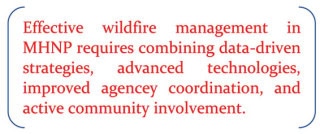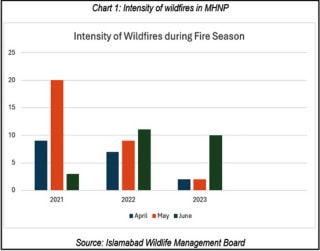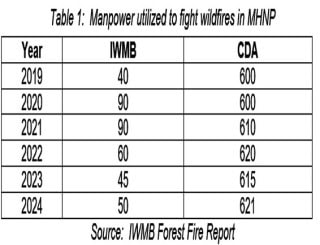Wildfires pose a substantive threat to individuals, property, and entire ecosystems. The last two decades have observed an alarming increase in such instances and the potential of wildfires to wreak havoc all around the globe. Pakistan is not aloof from such happenings either. The Margalla Hills National Park (MHNP), near Islamabad, has become a hotspot for repeated natural and man-caused wildfire incidents with alarming spikes in the fire season (April-June). As shown in Chart 1. This insight aims to analyse the causes of wildfires in MHNP and the wild firefighting capabilities of Islamabad. It also identifies the shortcomings and offers policy recommendations to enhance future wild firefighting capabilities.
 With its prolonged heat waves, climate change has significantly escalated the risk of wildfires. The increased dryness of vegetation, coupled with the abundance of dry grass and leaves, has made the MHNP more susceptible to ignition. From 2001 to 2023, the park endured 380 fire incidents, resulting in 500 hectares of forest cover loss. Figure 1 illustrates the staggering tree cover lost due to these wildfires, underscoring the gravity of the situation.
With its prolonged heat waves, climate change has significantly escalated the risk of wildfires. The increased dryness of vegetation, coupled with the abundance of dry grass and leaves, has made the MHNP more susceptible to ignition. From 2001 to 2023, the park endured 380 fire incidents, resulting in 500 hectares of forest cover loss. Figure 1 illustrates the staggering tree cover lost due to these wildfires, underscoring the gravity of the situation.
A substantial portion of wildfires in MHNP are the result of human negligence or intentional arson. Rina Saeed Khan pointed out, “Many fires inside MHNP are not natural forest fires, and about 80-90% of fires were set by humans.” Hikers and picnic goers sometimes unintentionally ignite fires because of their negligent behaviour. Arson incidents are also the cause of wildfires in MHNP.
Islamabad Wildlife Management Board (IWMB) and Wildlife Conservation Unit are the premier institutions mandated to conduct preventive, response, and rehabilitation measures in case of wildfires in the MHNP. IWMB also serves as the ‘legal guardian’ of the park under Section 21 of the Islamabad Wildlife Protection, Preservation, Conservation, and Management Ordinance, 1979. IWMB is a government-funded body under the Ministry of Climate Change and Environmental Coordination, which oversees environmental policies and regulations, including those related to wildlife management and firefighting. Capital Development Authority (CDA) and Metropolitan Cooperation Islamabad (MCI) collaborate and assist IWMB in ensuring effective wildlife management. The Wildlife Conservation Unit is mandated to safeguard the wildlife species and their habitats within the park’s premises. It also supervises the forestation in these premises, conducting periodic raids targeting illegal wildlife hunting and timber extraction. These departments collectively address wildfire challenges with a multi-fold approach, compromising on spreading awareness and enhancing responsive behaviour within MHNP.
 Currently employing traditional techniques to fight wildfires, IWMB utilises equipment, including fire beaters, leaf scrappers, and axes. These tools create firebreaks, clear vegetation, and manually extinguish fires. One key component of IWMB’s current strategy is to hold periodic patrols and conduct community awareness programmes on a limited scale with additional support from CDA and MCI. In extreme wildfire situations in MHNP, Mi-17 and Bell 412, helicopters from the Pakistan Army or National Disaster Management Authority (NDMA) are deployed for aerial support to fight wildfires. These helicopters use Bambi buckets to drop water and fire retardants to help control and extinguish the fires. However, these measures are often insufficient due to limited workforce and resources, according to IWMB officials. Table 1 shows the workforces utilised during the last six years for firefighting in MHNP.
Currently employing traditional techniques to fight wildfires, IWMB utilises equipment, including fire beaters, leaf scrappers, and axes. These tools create firebreaks, clear vegetation, and manually extinguish fires. One key component of IWMB’s current strategy is to hold periodic patrols and conduct community awareness programmes on a limited scale with additional support from CDA and MCI. In extreme wildfire situations in MHNP, Mi-17 and Bell 412, helicopters from the Pakistan Army or National Disaster Management Authority (NDMA) are deployed for aerial support to fight wildfires. These helicopters use Bambi buckets to drop water and fire retardants to help control and extinguish the fires. However, these measures are often insufficient due to limited workforce and resources, according to IWMB officials. Table 1 shows the workforces utilised during the last six years for firefighting in MHNP.
A key factor that hinders the response to fighting wildfires in MHNP is the lack of coordination and communication between concerned stakeholders. According to Rina Saeed Khan, chairperson of the IWMB, “More than equipment, we need better coordination with the CDA and other relevant departments,” as no central combined command centre or communication line exists. There exists no mechanism to conduct regular joint drills to enhance coordinated responses.
The link between human activities and wildfires can only be broken through community involvement. We can make a significant difference by promoting responsible behaviour within the park through awareness campaigns, educating and engaging local communities in fire monitoring and prevention, and strictly enforcing laws against intentional wildfires. Community workshops on fire safety can inform residents about preventing accidental fires, while volunteer fire watch groups can monitor high-risk areas and report any signs of wildfires. Incentives such as recognition awards can motivate community members to participate actively in wildfire prevention efforts, highlighting the crucial role of the community in this endeavour.
Establishing a central command centre with real-time communication tools can streamline IWMB, MCI, and CDA coordination. Interagency meetings at regular intervals can ensure that all stakeholders progress in the right direction on the same wavelength to respond more effectively to wildfire incidents. A shared digital platform for real-time updates can improve resource allocation coordination during relief operations. A mechanism for regular joint drills is needed to enhance coordinated responses to wildfires.
 Artificial Intelligence (AI) advancements offer new avenues to combat devastating wildfires. These technologies can efficiently detect early signs of wildfires, thus allowing the authorities to respond more quickly. For instance, the ‘Fire Guard,’ an AI-powered tool, was successfully put to pilot testing and could detect the possibility of a potential wildfire in MHNP well before it could even start. Similarly, in the United States (US), a pilot project, ‘Alert California Program,’ demonstrated a 30% reduction in wildfire response times using AI-powered technologies. This programme uses a network of cameras equipped with AI to monitor the landscape 24/7. These cameras detect smoke and alert fire officials, helping them respond more quickly. Due to financial constraints and rugged terrain in MHNP, the Pakistani authorities can use drones instead of cameras to monitor wildfires during the fire season. Drones equipped with thermal imaging cameras can monitor large areas and provide real-time data to firefighting teams.
Artificial Intelligence (AI) advancements offer new avenues to combat devastating wildfires. These technologies can efficiently detect early signs of wildfires, thus allowing the authorities to respond more quickly. For instance, the ‘Fire Guard,’ an AI-powered tool, was successfully put to pilot testing and could detect the possibility of a potential wildfire in MHNP well before it could even start. Similarly, in the United States (US), a pilot project, ‘Alert California Program,’ demonstrated a 30% reduction in wildfire response times using AI-powered technologies. This programme uses a network of cameras equipped with AI to monitor the landscape 24/7. These cameras detect smoke and alert fire officials, helping them respond more quickly. Due to financial constraints and rugged terrain in MHNP, the Pakistani authorities can use drones instead of cameras to monitor wildfires during the fire season. Drones equipped with thermal imaging cameras can monitor large areas and provide real-time data to firefighting teams.
In conclusion, as Pakistan battles challenges in combating wildfires that pose a severe threat to its already weak forestation system, the need to design a multidimensional approach with modern methods, AI-equipped tools, concerted efforts, better resources, and community involvement arises to ensure timely and effective responses to reduce and eventually eliminate the threat of wildfires.
Written by: Daniyal Qudratullah Email:daniyal.langove@yahoo.com










